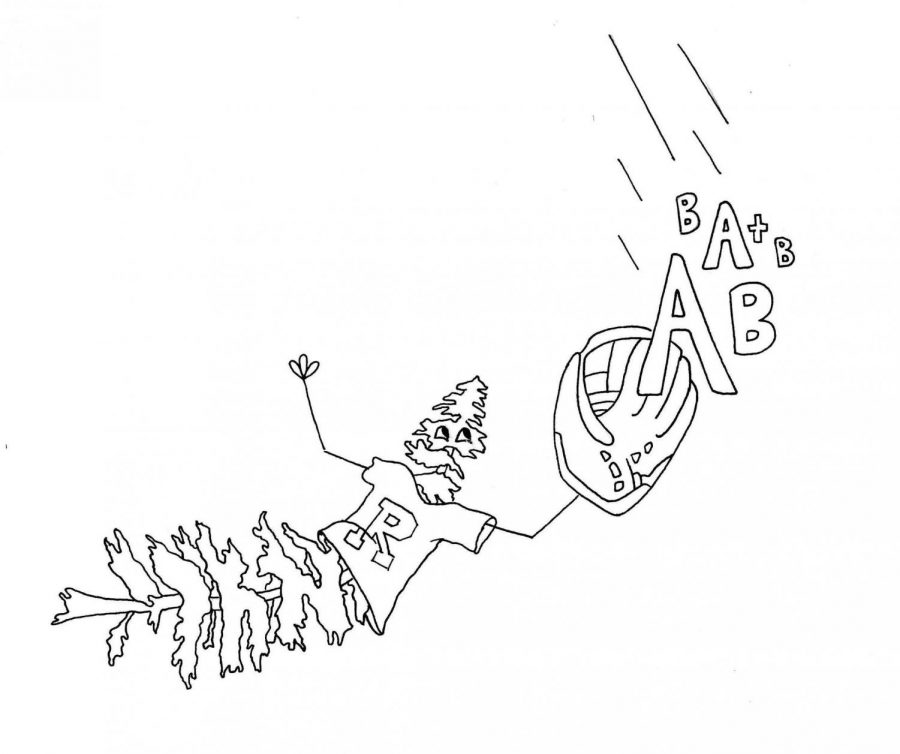Redwood makes the words ‘student’ and ‘athlete’ an uncooperative duo
May 2, 2019
Walk through any high school and you will find a trophy case commemorating high achieving sports teams or a plaque paying tribute to national champions in some sport from 20 years ago. At Redwood, the gym walls are covered with pennants honoring the many teams that have won the MCAL for their sport, or moved on to win NCS. While many look up to these achievements (quite literally, in the gym’s case), few consider the academic struggles that many of these athletes might have endured.
The Redwood community encourages students to compete in athletics representing our school because, in many cases, it reduces stress, increases school spirit and improves both physical and mental health. However, many student-athletes struggle to succeed with high pressures from both sports and school. While it is possible to excel in both, it is much harder than it needs to or should be. Redwood should make schedules to accommodate student-athletes in order to improve learning, decrease stress and demonstrate that the school does not condone missing classes.
Redwood student-athletes miss one and a half classes every two weeks on average, according to a sample of Redwood athletes from a recent self-reported Bark survey. This means that a three month season will result in a total of nine absences, resulting in two weeks of missed material for any given class. Especially for Advanced Placement (AP) classes or other lecture-based courses, these absences could have a large impact on the student’s ability to understand the subject, as lectures are, by nature, difficult for most students to make up.
School-related stress has become an increasingly prevalent aspect of life in Marin, mainly due to many high-achieving parents and students’ strong academic drives. Mental health has become one of the main focuses of the Wellness Center on campus, with the school often providing resources and education regarding various disorders linked to academic stress. Ironically, while playing sports is supposed to decrease stress because of the endorphins released while exercising, missing school for sports events has the opposite effect. For example, I have missed my seventh period of AP European History class almost five times for Redwood varsity girls’ soccer. Being absent from multiple periods has increased my stress levels because I constantly feel as if I have missed something and am trying to make up work.
I am surely not the only athlete that has experienced this type of academic stress as a result of athletics. Last season, there were seven underclassmen on my team, all of which struggled while missing seventh and even part of sixth period for games, similar to myself. Though participating in sports is a personal choice, the school has done little to help ease the load.
Chronic truancy, or missing 30 minutes of instruction without an excuse three times during the school year, is a major problem faced by schools across the U.S. This issue could be a possible result of systems like the one currently used by Redwood. In a survey conducted by St. John Fisher College, 89 percent of teachers agreed that truancy affects student achievement levels in one or more of their classes. Allowing and even encouraging students to leave school early could lead students to believe that missing school is permissible. It is particularly important for faculty to discourage all forms of missing school when they have such strict policies on absenteeism. Redwood emphasizes that school should be the top priority, but they can not support that claim when their student-athletes must miss school regularly if they wish to compete on a sports team.
Despite many possible solutions, students miss school for athletics because the sun sets so early and the only way to fit in games is to miss seventh period. However, moving all games to Thursdays and Saturdays could help reduce these avoidable absences. By doing so, students would not have to miss school for warm-ups because of the earlier release at 2:30 in the afternoon on Thursdays and no school on Saturdays. This would create days designated for home games where students would either be competing in or spectating, which could also increase school spirit and student involvement. Another possible solution is the elimination of physical education (P.E.) as a two year requirement for student-athletes. While this may be an argument in and of itself, eliminating P.E. would allow students to only take six classes, meaning they would not be forced to miss seventh period for athletics.
The choice between school or sports should not be one that student-athletes have to make at Redwood. The administration should make a larger effort to accommodate such a large part of our student body. The name student-athlete implies that one can be both a student and an athlete at the same time. The order also suggests that being a student comes first, as it should, but Redwood needs to make changes in order to ensure that we do not change into athlete-students.







